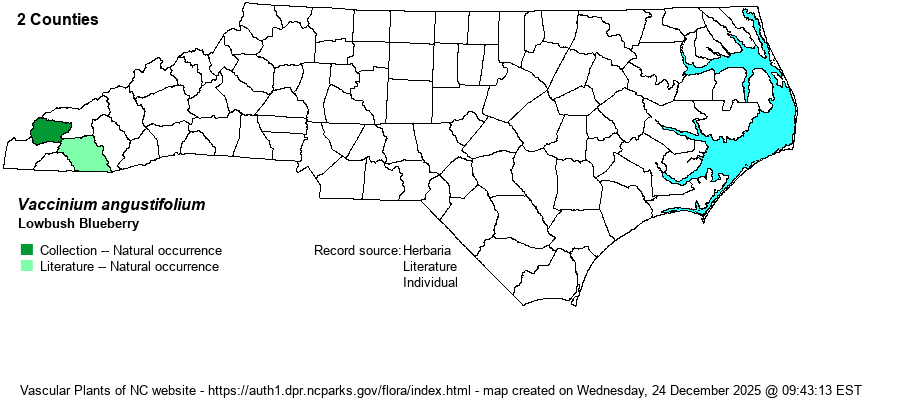| Author | Aiton | |
| Distribution | Despite this being a Northern species, the only records (so far) for NC are from the extreme southern Mountains. The 2010 Graham County specimen from Cheoah Bald is accepted (Schwartzman s.n. NCU). Macon County is reported by NCNHP. Swain (herbarium GSMNP) and Transylvania (herbarium WCUH) specimens are actually V. pallidum. A specimen from Buncombe County (herbarium WWC) lacks an image and needs vetting. To be looked for in the northern and central Mountains, as it occurs in several VA counties that border NC.
This “far Northern” species ranges from eastern Canada south throughout NJ and PA, and then south in the Appalachians to southwestern VA, and disjunct to southwestern NC. It has not yet been found in TN or KY.
| |
| Abundance | Very rare, and certainly easily overlooked. Only recently discovered in NC (in 2010), and it is listed by the NCNHP as a Significantly Rare species. | |
| Habitat | It occurs at high elevation (over 4000 feet) acidic shrub balds, exposed mountaintops and ridges, and open, dry, rocky forests. | |
| Phenology | Blooms from April to June, after the leaves have emerged; fruits from June to August. | |
| Identification | This is our lowest-growing ericaceous, deciduous shrub of the exposed mountaintops, balds, and high openings, growing mainly only to 8 inches to 2 feet tall. It can be confused with several other blueberries, as the twigs are generally greenish like others, though they can be brown more toward the base. However, the leaves are narrowly elliptic to slightly lanceolate and more sharply pointed at both ends than similar species; they are essentially entire. So, identify the species primarily by its mainly very short stature (about 1-foot tall) and the slightly narrower and more “pointy-looking” leaves. Though this is a long-known and good species, as with V. altomontanum it is poorly known in the state and can be easily passed over as V. pallidum or another species around high elevation balds and outcrops unless you carefully study each blueberry you encounter! | |
| Taxonomic Comments | In the past, the species has been given a number of varieties, but Weakley (2018) and most recent references do not support such varieties.
| |
| Other Common Name(s) | Northern Lowbush Blueberry, Low Sweet Blueberry, Late Lowbush Blueberry, Common Lowbush Blueberry. There are quite a few Vaccinium species known as “Lowbush Blueberry”. It might be better to give these with three-word names, such as “Northern Lowbush Blueberry”, for this species. However, as V. pallidum is given the common name here of Hillside Blueberry, it is usually better to limit common names to two words instead of three, even if that means a loss of taxonomic relationship. | |
| State Rank | S1 | |
| Global Rank | G5 | |
| State Status | SR-P | |
| US Status | | |
| USACE-agcp | FACU link |
| USACE-emp | FACU link |

